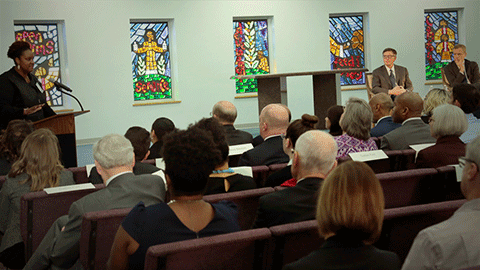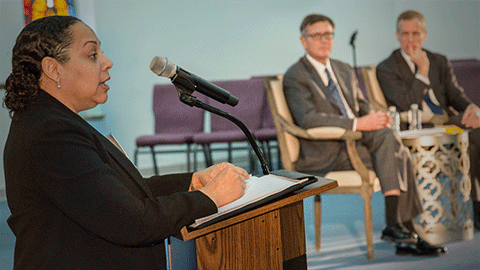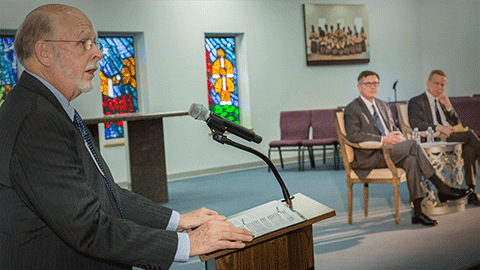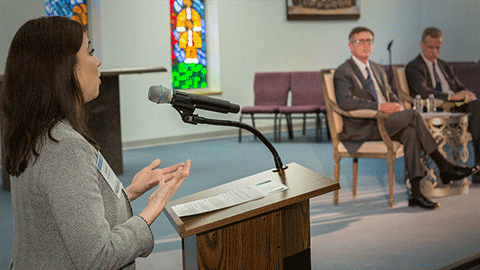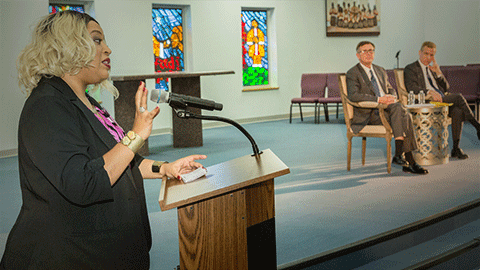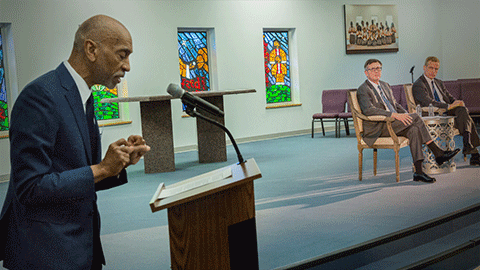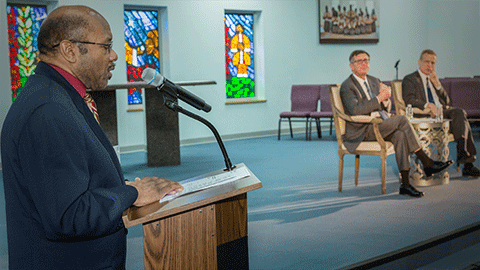
Fed Listens Community Listening Session
Summary of Discussion
The Federal Reserve Bank of Dallas held a Fed Listens community listening session Feb. 25, 2019, at St. Philip’s School and Community Center in southern Dallas. The event was hosted by Federal Reserve Vice Chairman Richard Clarida and Dallas Fed President Robert Kaplan.
The neighborhood surrounding St. Philip’s, commonly known as South Dallas, is historically underserved and faces many economic challenges. These were highlighted during a brief community tour to provide context for the discussion. The tour included a stop at CitySquare, a nonprofit that provides social services, economic opportunity and workforce programs, and affordable housing solutions.
The listening session featured speakers from nonprofit organizations active in the neighborhood. The organizations were selected to represent areas of focus significant to the South Dallas community:
Each speaker presented prepared remarks, responding to questions provided by the Dallas Fed. The questions supported the Federal Reserve’s review of monetary policy strategy, tools and communications.
Observations on Jobs, Inflation and Interest Rates
The speakers offered a number of perspectives that connect with the Fed’s monetary policy goals of full employment and stable prices. Reflecting the high unemployment rate in South Dallas, speakers cited the negative impact of unemployment on all aspects of community life—health, nutrition, education, housing, access to credit and more. Additionally, they emphasized the limitations of employment in South Dallas. Most opportunities there are low-quality, low-wage jobs, they reported, and many employed residents are among the “working poor,” struggling to make ends meet on low hourly wages.
Tahvia Merrill of Miles of Freedom elaborated. “It’s not good enough to ask if the people I serve have the ability to ask for higher hourly wages,” she said. “Taking an individual from $8 an hour to $10 an hour is not going to substantially impact their quality of life.”
Taking an individual from $8 an hour to $10 an hour is not going to substantially impact their quality of life.
—Tahvia Merrill, Miles of Freedom
Concerns about inflation were expressed especially with regard to older adults, many of whom are living on fixed income—often Social Security alone—without savings. For this growing demographic, Steve Benton of The Senior Source noted, stable prices are “crucial.” With people living longer, they face more years in retirement on a fixed income, making inflation a threat to their financial viability as their fixed-income buying power declines over time. Moreover, Benton said, seniors experience a higher inflation rate than that of the overall economy due to their higher expenditures on health care.
Other concerns about rising prices related to pressures on housing costs due to encroaching gentrification.
Perspectives on interest rates came from discussions of access to credit and the cycle of debt in this asset-poor community. Credit issues impact housing affordability even in an environment of lower interest rates, Chris Simmons of Cornerstone Baptist Church observed. Many South Dallas residents have poor credit (credit scores of 525 or less) and are vulnerable to predatory lending, accessing loans only at extremely high interest rates.
With interest rates now rising, Shaylon Scott of On the Road Lending suggested, performance on auto loans is starting to deteriorate, placing borrowers further at risk. An individual’s credit, once destroyed, can take a decade or more to rebuild, Scott said—noting that some South Dallas residents are still trying to rebuild their credit following the recession.
Key Concerns from Session
In addition to observations regarding jobs and inflation, the speakers emphasized three key concerns: transportation, location of job opportunities and the need for investment in the community. Lack of access to affordable, reliable transportation, they noted, impedes access to jobs, educational opportunities, grocery stores, social services and health care—making it a primary obstacle to economic opportunity, financial security and overall well-being.
Another issue highlighted was the relative scarcity of jobs in South Dallas. Simmons reported that less than 1 percent of jobs in Dallas are in the South Dallas neighborhood, and few of those jobs provide a living wage. High-opportunity jobs, several speakers noted, are generally located in distant parts of the metropolitan area, necessitating a lengthy commute.
To address the community’s economic issues, the speakers pointed to the need for investment in many areas including education, business development, entrepreneurship, infrastructure, affordable housing, health and community resources. In particular, investment in building new affordable housing was identified as a critical need—a type of infrastructure, Simmons noted, vital to long-term economic and community health.
|
Community Snapshot
The area of southern Dallas featured (ZIP codes 75210, 75215 and 75216) is historically underserved and faces many economic challenges.
|
Session Speakers
Kellee Murrell
St. Philip’s School and Community Center
St. Philip’s School provides college preparatory education for grades pre-K through 6. The Community Center provides social services and resources that assist neighborhood families in enhancing their quality of life.
Providing an overview of economic and educational concerns in South Dallas, Kellee Murrell of St. Philip’s School identified poverty as the underlying issue. Residents “have the desire to change their community [and] living situation,” she said. “But they lack the financial resources and, in some cases, the knowledge and opportunity to move out of their current state.”
In South Dallas, Murrell said, 94 percent of students are economically disadvantaged. As an educator, she said, the goal is closing not just the achievement gap but the opportunity gap and income gap. “South Dallas residents are confronted with the reality that quality jobs are not in their neighborhood. They don’t have equal access to opportunities that their wealthier peers have.”
Observing that the financial circumstance into which students are born impacts their future success, Murrell said, “To improve the livelihood of our children, we have to improve the livelihood of their parents.” The greatest need, she said, is investment and restructuring. “The need in South Dallas … is the intentional financial investment towards education in order to lift someone out of poverty.”
Asked about the greatest constraint on education and economic progress, Murrell identified financing for after-school programs and transportation as critical needs—noting that interventions and instruction are not effective if children cannot get home afterward.
Tahvia Merrill
Miles of Freedom
Miles of Freedom supports individuals and families impacted by incarceration and helps men and women coming out of prison rebuild their lives through housing, employment and other opportunities.
Observing that Dallas has one of the highest concentrations of poverty in the nation, Tahvia Merrill of Miles of Freedom said the South Dallas community has remained resilient through entrepreneurship, trading goods and services within the community. She noted the question of how to leverage employment opportunities and foster economic opportunity.
South Dallas has both land and a labor force, Merrill said—“185 square miles of prime property” and “tens of thousands of people who are ready, willing and able to go to work.” Citing the need for capital, she noted the difficulty of producing capital in a community that is largely asset poor. “We must work with the people in the community through investments, development and entrepreneurship to lead to economic growth.”
Commenting on the employment landscape in South Dallas, Merrill stressed the need for higher-opportunity jobs with living wages and benefits. “It’s not good enough to ask if the people I serve have the ability to ask for higher hourly wages,” she said. “Taking an individual from $8 an hour to $10 an hour is not going to substantially impact their quality of life.”
She further emphasized that quality employment opportunities should be located within the local community. “We are not going to shift until changes are made in development, in investment, and our residents aren’t required to make a one-way, three-hour commute by train and bus to travel 30 miles … for a chance at substantial employment.”
Merrill called for investment in both the land and the people of South Dallas and for empowering residents to build businesses that would allow and encourage them to spend money in their own neighborhood. Alongside workforce development programs, she said, there is a need to engage corporations and investments, creating opportunities, entrepreneurship and capital to keep the momentum moving forward.
Steve Benton
Elder Financial Safety Center, The Senior Source
As a collaborative partnership between The Senior Source and the Dallas County Probate Courts and District Attorney’s Office, the Elder Financial Safety Center helps older adults avoid the dangers of financial uncertainty and exploitation.
Steve Benton of The Senior Source discussed economic and financial challenges of older adults in South Dallas, a key service demographic for his organization, and across the U.S., where 78 million baby boomers are coming into retirement. Financial viability and financial vulnerability are gateway issues for their safety and security, he said, affecting where they can live, what they can afford and whether they have access to transportation and services. He cited four key risks: longevity, inflation, health care and exploitation.
Explaining longevity risk, Benton said, “The biggest fear of the older adult is, surprisingly, not death—it’s running out of money.” With people living longer, they face more years in retirement on a fixed income. This leads to inflation risk, as “their fixed-income buying power shrinks as the cost of everything they need to live rises over time.”
Further, the inflation rate experienced by seniors is higher than that of the overall economy due to higher expenditures on health care—13 percent of expenditures by Americans over the age of 65, compared to 5 percent for other age groups. Health care inflation, Benton noted, historically has risen at double the general inflation rate. Due to these risks, he said, price stability is “crucial.”
Several factors increase financial vulnerability, Benton said. For seniors in South Dallas, Social Security is often the only source of income. More generally, many baby boomers are entering retirement still owing mortgages, and some older seniors turn to reverse mortgages, which consume home equity, when they need money for basic expenses.
Older adults are also at risk for financial exploitation by scammers, businesses, family members, caregivers and friends. Citing the example of an 83-year-old South Dallas man who went to a dealership for an oil change and was sold a new car with a “subterranean-prime” loan, Benton said older adults are “vulnerable to predatory lending, payday loans and title loans with extraordinary fees and interest.” It is not uncommon, he said, to find 80-year-olds with over $25,000 in credit card debt, able to make minimum payments only, with no hope of ever paying it off.
Asked what percentage of his clients have no savings at all, Benton said, “A majority of South Dallas [seniors] do not have any savings, nothing to fall back on. Sometimes they own their house.”
Sara Gorath
North Texas Food Bank
North Texas Food Bank is a hunger relief organization that distributes donated, purchased and prepared foods through a network of more than 200 partner agencies in 13 counties. It operates a community food pantry at St. Philip’s.
The level of food insecurity in South Dallas, Sara Gorath of North Texas Food Bank said, “is one of the highest in our service areas.” She identified the neighborhood as a “food desert” with limited access to grocery stores or fresh produce. Many of the food bank’s clients, primarily seniors and disabled adults, access most of their groceries at a local convenience store.
In broad economic terms, Gorath said, “here in South Dallas … hunger is a symptom of a much larger problem.” Many clients face multiple barriers that limit their access not just to food but to a wide range of resources, social services and benefits. This can impact both their health and their economic security, she noted. Transportation is a challenge, especially for people in wheelchairs, she said, and many people lack mobile phones or computers—or even utensils to be able to cook.
“Getting a few blocks just to our pantry down the street can be really challenging,” Gorath said. “So knowing that and understanding, we’ve been able to gather a lot of information about what our clients need and how to better partner with other community agencies to provide wraparound services.” Clients coming to the pantry can enroll in supplemental nutrition and other benefit programs, access health education and services, and get referrals to other resources.
Asked the extent to which South Dallas is underserved in terms of food pantries, Gorath said distribution and access are the main issues, citing the need for transportation and awareness of resources. Asked about constraints to expansion, she identified a need for more space, noting that “the need in South Dallas … is so large that, just last week, we enrolled 30 new clients.”
Shaylon Scott
On the Road Lending
On the Road Lending provides vehicle selection assistance and long-term financial mentoring to help low-income individuals and families overcome transportation barriers so they can get to work and avoid predatory lending. It helps people improve their credit and purchase fuel-efficient, reliable cars, financing them through a private-equity loan fund with a low-cost loan.
Shaylon Scott of On the Road Lending highlighted the roles of transportation and vehicle ownership in improving the economic situation of individuals and families. Transportation, she said, is “the engine that drives our ability to work, to go to school, to get to the grocery store, to maintain our lives.”
The Dallas metro is geographically vast and expanding rapidly, Scott said, and it has a spatial mismatch—with lower-income families and higher-opportunity jobs in different areas. Mass transit does not serve all the area, making vehicle ownership important. “We can overcome food deserts … employment gaps, lack of access … simply if people have a way to get there.”
A vehicle can be a key asset for low-income families, she said, if it is not too costly to own and maintain. In South Dallas and similar communities, asset poverty is “a huge barrier.” Scott’s organization helps people acquire affordable, reliable vehicles and avoid predatory lending, to rebuild their credit and get out of the cycle of poverty and debt. From this perspective, she said, “we are keenly interested in how the actions of the Fed impact access to credit and interest rates.”
People in South Dallas who want to buy a car, Scott said, are often vulnerable to predatory lending at “tote the note” lots that charge up to 27 percent interest. Many residents have poor credit (credit scores of 525 or less) and believe this is their only option. In addition, interest rates are rising and 7 million Americans are 90 days or more past due on their auto loans, she said. “As people’s performances are starting to deteriorate, their credit is deteriorating … so we need to give them the opportunity to have credit-building loans.”
Credit can be destroyed overnight, Scott said, but can take a decade or more to rebuild. In South Dallas, “even though it’s been seven years since the recession, we still have neighbors that are struggling to rebuild their lives, their credit.” Elsewhere in Texas, people are working to rebuild their credit after Hurricane Harvey. Helping people overcome poor financial choices or catastrophic events, she said, “can save them not just money but struggle over the lifetime of their loans.”
Asked how her organization addresses these issues, Scott said it helps “people traditional banks are unable to help” by providing wraparound services—financial education, coaching and mentoring, and loans through a designated community development financial institution (CDFI) with a consistent interest rate of 9.75 percent.
Donald Wesson
Baylor Scott & White Health and Wellness Center at the Juanita J. Craft Recreation Center
Baylor Scott & White Health, the largest not-for-profit health care system in Texas, includes 48 hospitals and more than 800 patient care sites. It operates clinics in South Dallas, including one soon to open at St. Philip’s.
Donald Wesson of Baylor Scott & White Health highlighted the distinction between health and health care, emphasizing that health depends on a “health recipe” of three factors: health care, healthy nutrition and healthy physical activity. Health care contributes only about 20 percent to overall health, with 60 percent contributed by correctable environmental factors such as nutrition and physical activity. The lack of investment in an infrastructure that provides these supporting elements, Wesson said, is devastating to the health of impoverished communities.
In South Dallas, he said, poverty limits access to all three “ingredients” of the health recipe. Lack of transportation is also an issue, limiting the ability of residents to get to existing facilities in the neighborhood. Solutions to address this include encouraging non-health-care entities to co-invest with health-care entities to provide complementary services and resources in one location.
There are already successful models for this in South Dallas, Wesson said, for example, locating a clinic in a city recreation center. He called for additional investment in these existing models. “This investment will yield improved health in our community that will then allow individuals to contribute to the economic viability of their families, of their communities, and of our city and state.”
Wesson cited unemployment as a key economic factor that affects community health. “Unemployment contributes in a mighty way, and … unemployment is a real challenge in our community.” High unemployment, he said, limits access to employer-based insurance that can finance health care, while also limiting the funds available to purchase health services. Increased unemployment also increases poverty, he said, further limiting access to all the resources that support health for South Dallas residents.
Asked how Dallas is doing compared to other U.S. cities in supporting the health ecosystem, Wesson pointed to the opportunity to overlay health care and nutrition services at the city’s 43 recreation centers. He reiterated the need for investment, noting interest from for-profit companies that want to reduce absenteeism.
Chris Simmons
Cornerstone Baptist Church and Community Development Corporation
Cornerstone CDC leads community development and revitalization efforts in blighted areas of South Dallas/Fair Park. In partnership with the City of Dallas, Cornerstone CDC has purchased abandoned properties for use in building new affordable homes.
South Dallas has a great need for new, affordable homes, said Chris Simmons of Cornerstone Baptist Church. Describing the housing landscape, he highlighted the impact of population loss, poverty, aging housing stock and outdated infrastructure.
Since the 1970s, Simmons said, there has been a “hemorrhage” of residents. The population has declined by over 54 percent, he said, resulting in a large amount of vacant land (70 to 80 percent in some areas) and erosion of the tax base. Median household income in South Dallas is below the state average and median house value is significantly below average, while housing age is significantly above average, with the majority of homes built before 1939.
Economic growth in the region has led to expansion of Dallas’ central business district, bringing new interest in purchasing homes in close-in, formerly blighted and neglected neighborhoods such as South Dallas—but rising costs can push current residents out, Simmons said. “In the name of urban renewal, many people hear urban removal.” New, less-affordable development drives up tax values in the area, he noted, creating challenges for seniors who own their homes but live on tight budgets. Prices of existing homes are also rising.
Credit issues further impact affordability, Simmons said, even in an environment of lower interest rates. Many individuals in the community do not have access to credit, he said, with some entering adulthood with their credit already damaged, for example, due to parents using a child’s social security number to turn on utilities and then not paying the bills.
Simmons cited the job market as a key factor influencing access to housing for South Dallas residents. “In our neighborhoods, we have very few jobs available that provide a livable wage.” Only 1 percent of Dallas jobs are located in South Dallas, he said, and unemployment among residents is high; a 2012 study found a 16.5 percent unemployment rate in South Dallas compared to 5.1 percent in the Dallas-Fort Worth area. He added that many residents are among the “working poor,” who work many hours but struggle to make ends meet.
Simmons advocated a view of affordable housing as infrastructure, vital to long-term economic and community health.
For More Information
Contact Molly Hubbert-Doyle with any questions.
